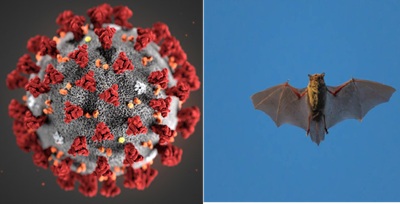New Bat Coronavirus HKU5-CoV-2 Discovered in China: Could It Trigger a Future Pandemic?
New Bat Coronavirus HKU5-CoV-2 Raises Fears of Future Pandemic
Beijing, China – A newly discovered bat coronavirus, named HKU5-CoV-2, has sparked global concern after scientists in China revealed its ability to potentially infect humans. With echoes of the COVID-19 pandemic that devastated the world, researchers are cautious but wary of the virus’s ability to spread from animals to humans. Although the virus has a lower efficiency in infecting humans than SARS-CoV-2, the virus responsible for the ongoing COVID-19 pandemic, the discovery has raised alarms about future spillover risks.
Chinese team finds coronavirus that could infect humans via same route as Covid https://t.co/1kgR7zORHt
— South China Morning Post (@SCMPNews) February 21, 2025
The HKU5-CoV-2 virus was discovered in bats in southern China, and its genetic makeup has led researchers to believe that it could potentially trigger a future public health crisis. The virus has been found to bind to human ACE2 receptors—just like SARS-CoV-2—an entry point for many coronaviruses into human cells.
What Is HKU5-CoV-2 and Why Should We Be Concerned?
HKU5-CoV-2 belongs to the coronavirus family, a group of viruses known for causing illnesses in both animals and humans. This particular virus was detected in bat populations, which have been recognized as a primary source of zoonotic viruses—those that can jump from animals to humans. Scientists in China have reported that the virus exhibits the potential for animal-to-human transmission, which is a key concern for the possibility of a future outbreak.
Despite these warnings, initial studies suggest that the virus’s ability to infect humans is currently lower than that of SARS-CoV-2, the virus behind the COVID-19 pandemic. However, experts are cautious, as the evolutionary characteristics of viruses like HKU5-CoV-2 can change over time, making it more capable of spreading and potentially becoming a serious threat.
The Science Behind the Concern
The primary reason researchers are concerned about HKU5-CoV-2 is its ability to bind to human ACE2 receptors, similar to the way SARS-CoV-2 operates. ACE2 receptors are found on the surface of human cells, and many coronaviruses—including SARS-CoV-2—use these receptors to gain entry into human tissues.
This discovery suggests that HKU5-CoV-2 may have the ability to infect humans, particularly if mutations allow the virus to adapt more efficiently to human cells. The virus’s presence in bats is especially concerning because bats are known to harbor various coronaviruses, some of which have caused past outbreaks.
Although there is no indication that HKU5-CoV-2 is capable of widespread human-to-human transmission at this stage, scientists warn that the potential for future mutations or adaptations exists. If the virus were to adapt further and begin spreading more effectively between humans, it could lead to a pandemic situation similar to COVID-19.
The Spillover Risk and What It Means for the Future
Researchers have highlighted the spillover risk—the possibility of a virus jumping from animals to humans—as one of the greatest concerns with the discovery of HKU5-CoV-2. Spillover events are difficult to predict but have been responsible for the emergence of past pandemics. SARS-CoV-2 itself is believed to have originated from a similar spillover event involving bats and possibly an intermediate animal host.
The recent discovery of HKU5-CoV-2, coupled with the global experience from the COVID-19 pandemic, has reignited fears about future pandemics. Scientists are monitoring the virus closely to understand its ability to mutate and adapt to new hosts, including humans. Early indications suggest that, while the risk of human infection is currently low, the potential for future mutations makes it a virus to watch carefully.
In addition to its genetic similarities to SARS-CoV-2, the recent discovery of HKU5-CoV-2 highlights the need for increased global surveillance and early detection of zoonotic viruses. These measures are critical for preventing future outbreaks and minimizing the risk of another pandemic.
Global Implications: What Can Be Done?
The discovery of HKU5-CoV-2 calls for heightened international cooperation in virus research and containment strategies. It serves as a reminder of the delicate balance between animal and human health, especially as environmental changes bring animals into closer contact with human populations.
Public health experts recommend continued vigilance in monitoring wildlife populations for potential new viruses. Improved detection systems, coupled with a more robust response infrastructure, could help contain such viruses before they spread globally. Early detection and rapid response are crucial in preventing potential spillover events from escalating into widespread pandemics.
In addition, greater emphasis should be placed on protecting ecosystems and reducing human interference in wildlife habitats. Deforestation and climate change can exacerbate the risks of zoonotic diseases by bringing humans into closer proximity to wildlife, increasing the likelihood of spillover events.
Conclusion: A Virus to Watch Closely
The discovery of HKU5-CoV-2 is a stark reminder of the constant threat posed by zoonotic diseases. While this particular virus may not pose an immediate danger to global public health, its ability to infect humans—combined with the potential for future mutations—warrants ongoing attention and research. Governments and public health organizations worldwide must stay vigilant and prepared for the possibility of new pandemics emerging from animal-to-human transmission.
As scientists continue to study HKU5-CoV-2, the world must remain aware of the ongoing risk of zoonotic diseases. Lessons learned from the COVID-19 pandemic must guide future efforts to prevent the next global health crisis.

